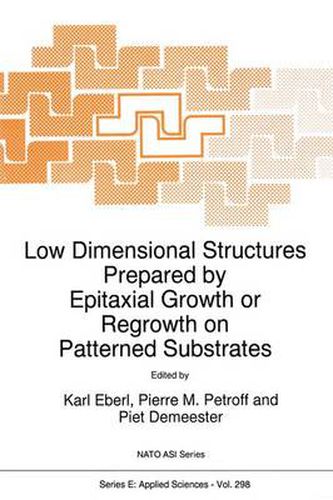Readings Newsletter
Become a Readings Member to make your shopping experience even easier.
Sign in or sign up for free!
You’re not far away from qualifying for FREE standard shipping within Australia
You’ve qualified for FREE standard shipping within Australia
The cart is loading…






This title is printed to order. This book may have been self-published. If so, we cannot guarantee the quality of the content. In the main most books will have gone through the editing process however some may not. We therefore suggest that you be aware of this before ordering this book. If in doubt check either the author or publisher’s details as we are unable to accept any returns unless they are faulty. Please contact us if you have any questions.
Significant experimental work is devoted to the preparation of one and zero dimensional semiconductor structures in view of future electronic and optical devices which involve quantum effects. The aim is good control in the realization of nanometer structures both in vertical and lateral direction. Conventional processing techniques based on lithography face inherent problems such as limited resolution and surface defects caused by reactive ion etching. During the last few years several research groups started working on direct syntheses of semiconductor nanostructures by combining epitaxial growth techniques such as molecular beam epitaxy and chemical vapour deposition with pre-patterning of the substrate wafers. Another idea is based on island formation in strained layer heteroepitaxy. Zero and one dimensional structures with dimensions down to a few atomic distances have been realized this way. An important point is that the size of the quantum structures is controlled within the epitaxial deposition in a self-adjusting process. The main subjects of the book are: theoretical aspects of epitaxial growth, self-assembling nanostructures and cluster formation, epitaxial growth in tilted and non-(001) surfaces, cleaved edge overgrowth, nanostructure growth on patterned silicon substrates, nanostructures prepared by selective area epitaxy or growth on patterned substrates, in-situ etching and device applications based on epitaxial regrowth on patterned substrates. The experimental work mainly concentrated on GaAs/A1GaAs, GaAs/InGaAs, InGaP/InP and Si/SiGe based semiconductor heterostructures. Growth related problems received special attention. The different concepts for preparation of low dimensional structures are presented to allow direct comparison and to identify new concepts for future research work.
$9.00 standard shipping within Australia
FREE standard shipping within Australia for orders over $100.00
Express & International shipping calculated at checkout
This title is printed to order. This book may have been self-published. If so, we cannot guarantee the quality of the content. In the main most books will have gone through the editing process however some may not. We therefore suggest that you be aware of this before ordering this book. If in doubt check either the author or publisher’s details as we are unable to accept any returns unless they are faulty. Please contact us if you have any questions.
Significant experimental work is devoted to the preparation of one and zero dimensional semiconductor structures in view of future electronic and optical devices which involve quantum effects. The aim is good control in the realization of nanometer structures both in vertical and lateral direction. Conventional processing techniques based on lithography face inherent problems such as limited resolution and surface defects caused by reactive ion etching. During the last few years several research groups started working on direct syntheses of semiconductor nanostructures by combining epitaxial growth techniques such as molecular beam epitaxy and chemical vapour deposition with pre-patterning of the substrate wafers. Another idea is based on island formation in strained layer heteroepitaxy. Zero and one dimensional structures with dimensions down to a few atomic distances have been realized this way. An important point is that the size of the quantum structures is controlled within the epitaxial deposition in a self-adjusting process. The main subjects of the book are: theoretical aspects of epitaxial growth, self-assembling nanostructures and cluster formation, epitaxial growth in tilted and non-(001) surfaces, cleaved edge overgrowth, nanostructure growth on patterned silicon substrates, nanostructures prepared by selective area epitaxy or growth on patterned substrates, in-situ etching and device applications based on epitaxial regrowth on patterned substrates. The experimental work mainly concentrated on GaAs/A1GaAs, GaAs/InGaAs, InGaP/InP and Si/SiGe based semiconductor heterostructures. Growth related problems received special attention. The different concepts for preparation of low dimensional structures are presented to allow direct comparison and to identify new concepts for future research work.